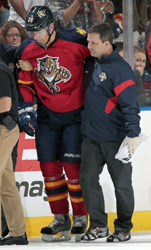Teams are obligated to pay for care due to injuries sustained by athletes while playing for the organizations. Labor agreements from the top four leagues contain pages of rules governing the treatment of injured players and the subsequent roster moves often needed. Here are a few highlights:
■ NBA
Teams can apply for an extra roster spot if they claim hardship due to a player injury or illness. They can apply to the league to get an extra roster spot (to sign a replacement player to a 10-day contract) if they have four players who have each missed three consecutive games and who will be unable to return to play for the next two weeks due to the injury or illness.
A team may replace a player who suffers a season-ending injury or illness with one player making up to 50 percent of the disabled player’s current salary.
A team can apply to have a player’s salary removed from the salary cap beginning on the first anniversary of the date of the last regular-season or playoff game in which the player competed.
■ NHL
 |
In the NHL, if a player is going to be out for an extended time, teams can exceed the salary cap when adding a replacement to the roster.
Photo by: Getty Images |
A provision in the labor agreement allows clubs to exceed the salary cap, known in the league as “the upper limit,” when replacing players who have an injury or illness that forces the players to miss at least 24 calendar days or 10 games.
However, if the league wishes to challenge the determination of the club physician that the ill or injured player is unfit to play, the NHL and the NHL Players’ Association must jointly select a neutral physician to review the case.
If that player is then deemed fit to play, he cannot return to the ice for the club until the team has created enough payroll room to stay below the salary cap.
These provisions are contained in the current NHL collective-bargaining agreement, which is set to expire in September.
■ NFL
Player contracts are not guaranteed, even for injury. Players get paid their full salary in the season of their injury, but aside from any bonus they may have received, they are not entitled to salaries in future years. However, in those then-defunct years of their contracts, if the players are cut, they can receive an amount equal to half their salary, but capped at amounts ranging from $1 million to $1.2 million.
Beginning in 2016, amounts like those will count toward the salary cap, according to the NFL’s new labor agreement.
When a player is injured, he is examined and treated by team medical professionals. If the player needs surgery, he can go outside the club for a second opinion, and have that professional perform the necessary surgery at the team’s expense. The club, according to the CBA, is not responsible for any liability that emerges from such a surgery.
Teams can have 53 active and inactive players on their roster. A team cannot bring on extra salary beyond the cap just because someone is injured.
■ MLB
A team is allowed to have players recover from injuries in one of three primary sites: the club’s home city, on the road with the club, or at the team’s spring training facility. In the latter instance, the stay at the spring training facility cannot exceed 20 days without written consent from the player.
Players on the 15-day disabled list do not count toward 25-man active team rosters (26 players for regularly scheduled day-night doubleheaders beginning this season). Players on the 60-day disabled list typically do not count toward larger 40-man rosters, which do include the 25 active players, injured players on the 15-day or seven-day disabled lists, and minor leaguers with major league contracts.
The league and the MLB Players Association prior to last season also created a new seven-day disabled list specifically for concussions and other head injuries. As part of the expanded awareness and treatment of head injuries within baseball, players must submit to neurocognitive baseline testing.
Since MLB contracts are guaranteed, players continue to get paid while on the disabled list, and accrue service time.
Sources: Leagues, SportsBusiness Journal research




